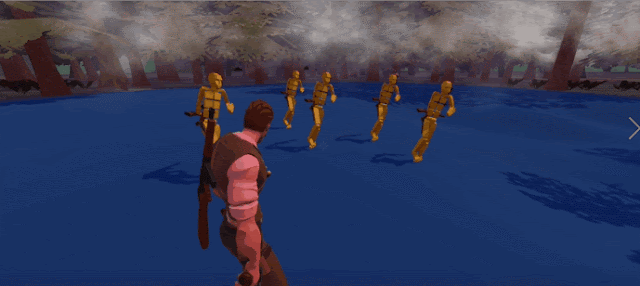The goal of this prototyping process was to try to merge together a variety of concepts and visions (in somewhat of a crass, copy/paste manner but that is the nature of "rapid" prototyping) I have for my final thesis game, namely the shooter genre in video games, queer culture such as vogueing and cruising, and the queering of space. I also wanted to test out the mocap system from Rokoko and see how it would work inside Unity.
What I learned
In the end, the quick prototype I developed revealed many problems, but that is a good thing and it allows me to now further develop and refine some of the original concepts I have. I learned that I in fact, quite enjoyed the condense period of making, even though I was frustrated that I didn't have more time to reflect on the making process, the lack of space for reflection forced me to do things and make decisions that I wouldn't normally consider. As I mentioned earlier, the rather crass, copy/paste and literal translation of some of the concepts I had is a crucial first step into refining and polishing your ideas. Normally, I would usually do this first step in my head or through paper and pen sketches, and then refining until I am ready to make something a bit more developed with a more polished idea. This of course puts me in a much less vulnerable position but making the first idea as close to the final piece as possible (in my case a game) opened it up to a more constructive feedback process, which ultimately puts me in a much stronger position to help me decide to make for my final game.
Feedback, what worked and didn't worked
In the final demo, Kate Hartman our program director gave me some really interesting feedback.
- "I think the presence of the gun should be explored a bit further. Not to say either way that it should be kept or removed, but perhaps more exploration around how / when / why it is used since it is such a loaded object. Also - I wonder whether it might be worth exploring a morphing or swapping of that object during the course of the dancer’s sequence."
Kate also asked me how the dancing will be further developed.
- "I’m also quite interested in potential interaction / interactivity between the player and the dancer(s) - not necessarily that their movements respond, but maybe their placement, the number of them, etc. I enjoyed seeing the one dancer on their own vs. the troupe of dancers."
I am interested in employing dance for a few different reasons. One, I have a background in performance art and dance and two, I wanted the dance to be a metaphor for queer sex. Dance in many ways is a sequence of choreographed body movements and gestures and the nature of dance is often nonverbal and expressive. Historically, queer culture also had to be nonverbal and expressed through gestures and in body and eye language. The vogueing was mostly a test, although I will definitely be using some of this mocap in my final game. The true intention of testing the mocap was to figure out what was possible, and how vogue, arguably the most visibly queer dance recognizable right now, would even look and translate in a game environment. I believe the vogueing was successful in that it was clearly queer, and that it made a very striking impression on the players. However, it also didn't work because the current presentation of the dance feels like a simple performance, and it lacks any interaction other than the player taking on the role of the spectator and the NPCs taking on the role as performers.
Ralph Escamillan vogueing
The game environment I used in this game ended up being recycled from a previous prototype that I never developed earlier this year. The environment was a scene of a lake in a park based on Stanley Park in Vancouver and was supposed to be a game that drew upon the gruesome attack and murder of Aaron Webster, who was found clubbed to death by baseball bats in an area inside the park that is a known popular spot for men to go cruising. Coincidentally, by recycling this scene, it revitalized this earlier idea that I threw away and I intend to now revisit some of the themes I was exploring which I believe are highly relevant to what I want to achieve for my final game. The story of Aaron Webster may provide an entry point into how I would write the story of my game and how might the shooter elements come into play. Moreover, the park environment proves to be really intriguing as a prospect space but I felt like to lacked built structures and refuge spaces.
Next steps
For my next iteration, I will work on several things. I have commissioned Ralph Escamillan (the dancer) to choreograph a sequence of contact dancing for two dancers which will be influenced by vogue movements. I will capture the mocap data for both dancers at the end of August. Next I will also start designing the final game environment which is the park, some built structures and the objects in that space, so I will start doing some photogrammetry work. Lastly, I will start thinking and writing the overarching story of the game, keeping in mind the story of Aaron Webster and the shooter (guns and mechanics) elements.
After this I want to start messing around with level designing and the scripting. I will explore how I could be playful with the paths in the games and scripting ways walls and paths could appear and disappear through different triggers such as dance.












No comments:
Post a Comment